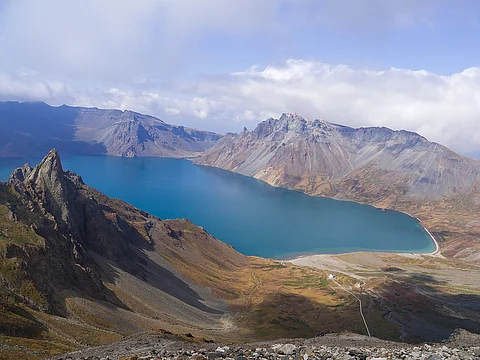
- Destinations
- Experiences
- Stay
- What's new
- Celebrating People
- Responsible Tourism
- CampaignsCampaigns
- Subscribe
- Buy Now

Mount Paektu, situated along the border between North Korea and China, has been officially recognised as a UNESCO Global Geopark. This marks the first time a natural site in North Korea has received such an honour. The designation, granted by the United Nations Educational, Scientific and Cultural Organisation (UNESCO), highlights the mountain’s considerable geological and cultural importance.
The announcement was made by UNESCO’s Executive Board following a review process that began on April 2 and considered several candidate sites, including this iconic peak—the tallest on the Korean Peninsula. This recognition marks a significant milestone for North Korea, as it is the first time a natural site within the country has received such international status. According to UNESCO, Global Geoparks are designated to regions with geological features of outstanding global value, managed with a holistic focus on protection, education, and sustainable development. Interestingly, the Chinese side of the mountain—known there as Changbai Mountain—has already been recognised under the UNESCO Global Geopark programme, listed under its Chinese name.
UNESCO granted official recognition to the site, citing its “impressive natural and cultural heritage.” This includes its dramatic volcanic eruptions, distinctive geological formations, and deep cultural significance. The designation acknowledges not only the mountain’s striking physical features but also its value as a site of scientific interest and cultural identity. UNESCO officials also highlighted the “Millennium Eruption” of Mount Paektu in 946 CE—one of the most powerful volcanic events ever documented in human history.
Mount Paektu is a towering stratovolcano that lies on the border between North Korea and China. Also known as a composite volcano, a stratovolcano like Mount Paektu is formed through successive layers of hardened lava, volcanic ash, and other ejecta. Typically found near subduction zones, these volcanoes are known for their steep, conical profiles and their potential for highly explosive eruptions.
UNESCO Global Geoparks are unified geographical areas that highlight sites of international geological importance—such as rock formations, fossils, and landforms—while also promoting education, conservation, and sustainable development. What sets them apart is their strong focus on community involvement. Local residents play an active role in managing and preserving these areas, fostering a sense of ownership and long-term support. Geoparks are not only about showcasing natural beauty; they also serve as platforms for raising awareness of key global issues like climate change, natural hazards, and resource management.
There are currently 229 UNESCO Global Geoparks in the world, located in 50 countries. India currently does not have any UNESCO Global Geoparks. While India has identified several potential geoheritage sites and is actively working towards developing geoparks, none have yet been recognised by UNESCO.
1. What is Mount Paektu and why is it significant?
Mount Paektu is an active stratovolcano on the China–North Korea border. It holds deep cultural and historical significance for Koreans and is considered the mythical birthplace of the Korean people. It is also known for its striking natural beauty, including Heaven Lake.
2. Why did UNESCO recognise Mount Paektu as a natural site?
UNESCO recognised Mount Paektu for its unique geological features, rich biodiversity, and cultural heritage value. The site represents one of the best-preserved volcanic ecosystems in East Asia and is vital to regional ecological balance.
3. Is Mount Paektu accessible to tourists?
Yes, but access is limited. On the North Korean side, tourism is highly regulated, typically available only via guided tours arranged by government-approved agencies. The Chinese side of the mountain is more accessible to international travellers.
4. What does this UNESCO recognition mean for North Korea?
It marks a major international acknowledgment of North Korea’s natural heritage. The designation could boost eco-tourism, promote environmental protection, and open limited avenues for scientific collaboration with international organisations.
